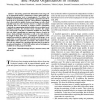Free Online Productivity Tools
i2Speak
i2Symbol
i2OCR
iTex2Img
iWeb2Print
iWeb2Shot
i2Type
iPdf2Split
iPdf2Merge
i2Bopomofo
i2Arabic
i2Style
i2Image
i2PDF
iLatex2Rtf
Sci2ools
TMI
2016
2016
Structure Tensor Based Analysis of Cells and Nuclei Organization in Tissues
—Extracting geometrical information from large 2D or 3D biomedical images is important to better understand fundamental phenomena such as morphogenesis. We address the problem of automatically analyzing spatial organization of cells or nuclei in 2D or 3D images of tissues. This problem is challenging due to the usually low quality of microscopy images as well as their typically large sizes. The structure tensor is a simple and robust descriptor that was developed to analyze textures orientation. Contrarily to segmentation methods which rely on an object based modeling of images, the structure tensor considers the sample at a macroscopic scale, like a continuous medium. We show that this tool allows quantifying two important features of nuclei in tissues: their privileged orientation as well as the ratio between the length of their main axes. A quantitative evaluation of the method is provided for synthetic and real 2D and 3D images. As an application, we analyze the nuclei orientatio...
| Added | 11 Apr 2016 |
| Updated | 11 Apr 2016 |
| Type | Journal |
| Year | 2016 |
| Where | TMI |
| Authors | Wenxing Zhang, Jérôme Fehrenbach, Annaick Desmaison, Valérie Lobjois, Bernard Ducommun, Pierre Weiss |
Comments (0)

